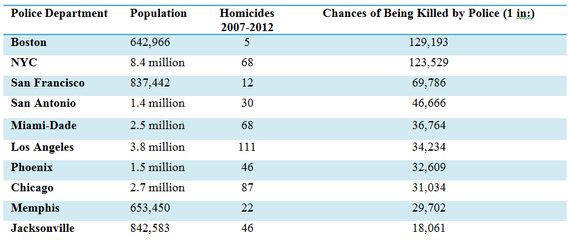Last week, in a rare bipartisan vote just before they adjourned for the year, the House and Senate passed a bill called the Death in Custody Reporting Act. The bill which is slated for a presidential signature, calls for all police departments to report all people killed in custody or during an arrest.
"You can't begin to improve the situation unless you know what the situation is," said Rep Bobby Scott in an interview with the Washington Post.
Good Luck.
The bill was originally passed in 2000, but expired in 2006. During those years not much data was collected, according to the FBI and most criminologists. Since the law expired eight years ago, Scott has unsuccessfully attempted to reinstate it four times.
But his bill was stalled until last week when Republican Senator Rand Paul called on a couple of colleagues and persuaded them to remove their holds, no doubt motivated by the national uproar following the deaths of Eric Garner and Michael Brown.
If we can ever get accurate data, adoption of best practices and procedures might result in hundreds, if not thousands, of lives saved annually as a result of a reduction in police shootings of unarmed persons. Neither the federal government, nor anyone else, has ever managed to collect reliable figures that might help bring this about.
A simple analysis of police homicides (overlaying population figures on to WSJ data) found wide discrepancies in the rate of police killings among major metropolitan police departments, when measured against population figures.
Contrary to popular belief, New York City---with a police homicide rate of 1 in 123,529 citizens---ranks near the top (best, least people killed) of large cities in the U.S. The NYPD killed 68 people from 2007 - 2012 out of a population of 8.4 million.
In Miami-Dade County, in a population of 2.5 million, (less than a third of the people living in NYC) police killed 68 citizens during that same five-year period. This means that citizens of Miami are 3.5 times more likely to killed by their local policeman than their counterparts in New York City.
An amalgamated review of police shooting data from the FBI, the Centers for Disease Control and Prevention (CDC) and figures from 105 major police departments (obtained by the Wall Street Journal) -- when compared with population figures -- revealed that the Los Angeles Police Department killed 111 citizens during this period in a population of 3.8 million, which works out to one police homicide per 34,234 persons. This indicates that the average citizen's chance of being killed by a policeman is nearly four times greater in Los Angeles than in New York City. (CORRECTION: This paragraph has been updated since publication to correct a misreading of the WSJ report)
Wilfrado A Ferrer, the United States attorney for South Florida, studied police shooting incidents in Miami and noted the high rate of Miami shootings when compared to New York. In 2010, there was one fatal shooting for every 4,300 officers in New York, compared to one for every 220 officers in Miami.
If all police enforcement departments used the best practices of New York and Boston, which came in first place, the figures indicate that well over half of police killings might have be avoided. More than 3,000 lives could have been saved during that five-year period.
Lowering the Rate of Police Killings
Lowering the rate of police killings and shootings is certainly possible. For example, police in NYC killed an average 71 people per year from 1970-72. After a number of highly publicized killings, the NYPD instituted stricter guidelines and more professional training. Police were banned from shooting at moving vehicles. The drop in police killings was dramatic. Only an average of 11 people were killed annually in 2011-2013.
Police shootings in NYC have also dropped dramatically since 1991: from 332 to 105. This may be related to overall dropping crime rates (an 85% drop in murders from 1990 to 2013) as well as better training and procedures. Los Angeles police recorded 164 shootings in 1990, and that number dropped to just 65 shootings in 2010.
Much of this comparative city data is incomplete and some years are missing (e.g. there is no data for Chicago for 2007.) But working with the best numbers available for police homicides (2007-12), see below:
The lack of a national data for fatal police killings is beset by systematic problems and "is a national embarrassment," says Geoffrey Alpert, a criminology professor at the University of South Carolina.
The figures for people killed by police vary widely from 2007-2012. FBI reports show 1,242 police killings in those years. The WSJ findings, reported recently, indicate the true number should be higher than 1,800. Including police killings in rural areas and small towns, the total might well be over 3,000 and possibly higher, according to a Wikipedia page on the subject. Real national figures do not exist on this, but local compilations from municipalities and local papers give some idea of what is going on.
The last time data of this kind was compiled was more than fifty years ago in an article in the Journal of Criminal Law and Criminology in 1963. In that study by Gerald D. Rubin, Boston was found to be the safest city and Miami was one of the most deadly.
More Utah citizens have been killed by police than by gang members, or drug dealers, or from child abuse in the past five years,, according to a recent report in the Salt Lake City Tribune.
Through October of this year, 45 people had been killed by law enforcement officers in Utah since 2010, accounting for 15 percent of all homicides during that period. If you narrow the number killed to those killed by a stranger, then almost 50 percent of the firearm homicides are attributable to police shootings. Most people, of course, are killed by their family and friends.
In 2013, only 29 people were killed by a stranger in NYC (8.7 percent out of some 334 overall murders). The numbers suggest that if you are killed by a stranger with a firearm, one third of the time your killer will be a policeman.
An NYPD analysis of police killings several years ago noted that police reports in the past had been based on "the mistaken assumption that in the majority of cases where a policeman uses his weapon to fend off an assault upon himself the perpetrator is attacking with a firearm."
"This is not true," the study went on to say. "Reports indicate that in excess of 60 percent of these situations, the weapon used was other than a firearm."Most Citizens Killed by Police Are Not Carrying a Firearm
A Washington Monthly review of NYPD Firearms Discharge reports from 2010 to 2012 shows that more than half of the 33 people killed during this three-year period were not armed with a firearm. Only 15 guns were found, eight knives, two fake guns, one cane, and one frying pan.
In 2012, of 16 people shot by police, seven were armed with a firearm. In 2011, nine citizens were killed and only four guns were found. One person, killed by mistake, was a policeman. In 2010, eight people were killed and only four had guns.
One private nationwide report says that of the 739 justified shootings in 2012, 44 percent of civilians killed, or 136 total, were unarmed. Twenty-seven percent of them (83) were claimed by law enforcement to have a gun at the time of the shooting, but according to news reports, that could later not be confirmed, or the "gun", in fact, was a toy or other non-lethal object according to "Operation Ghetto Storm."
One of the most striking findings emerged from a report by the New York Civil Liberties Union a few years ago: in 77 percent of total shooting incidents (572), police officers were the only ones firing weapons.
Only 23% of the time (131 incidents) were the police officers fired upon with an exchange of gun fire.
A report of violent deaths by the CDC in 16 states indicates that 3.4% of violent deaths are caused by police, and only 4.6% are caused by a stranger. The chances of an average citizen being killed by a policeman or a stranger are remarkably similar.
American police answer their critics by claiming that a moment's hesitation endangers innocent civilians. But the no-hesitation policy that cops traditionally use has killed more innocent people, including fellow police officers, than could ever be endangered by a little temperance. Finally, police say that guns are necessary for their own protection.The fact is that being a policeman is one of the safest jobs you can have.
In five years, 2008 to 2012, only one policeman was killed by a firearm in the line of duty in New York City. Police officers are many times more likely to commit suicide than to be killed by a criminal. Eight NYC policemen took their own lives in 2012, alone.
Comparatively, a fisherman is 10 times more likely to be killed on the job than a police officer, according to national figures from the Bureau of Labor Statistics. A logging worker is eight times more likely than a police officer to die on the job, and a garbage man is three times more likely to die while working.
Most policemen killed on the job die in auto accidents, according to FBI statistics.
Almost every major civil insurrection that occurred in the United States in the past century was initiated or accelerated by the perception that the police had misused their right to use deadly force, according to a report in the American Journal of Public Health. These incidents frequently cause large numbers of injuries and deaths, and they disrupt the social and economic relationships through which essential economic, health, public safety, and social services are provided to communities.
Two interesting statistics run counter to most media reports and widespread public perceptions:
1) The year 2013 had the fewest police deaths by firearms since 1887 nationwide.
2) Conversely, the number of citizens killed by police has been on a sharp downtrend for the last fifty years. This does not match FBI statistics, which show that show police homicides are rising. But the FBI has been underreporting police homicides for a long time. Hopefully, the Reporting Act will change this.
It is likely that more accurate reporting of late has led to rising FBI police homicide numbers. Reports from major police departments themselves show rapidly decreasing police killings of citizens. For example, New York City reports indicate that police homicides have fallen from 50 to 60 killings per year 50 years ago to 9 to 11 in recent years.
Keep in mind that 99.9 percent of all police arrests do not result in a fatality.
The lack of an accurate national database is intentional, according to Dr. Brian Burghart, who has been building a national database of police homicides. No government--not the federal government, and not the thousands of municipalities that give their police forces license to use deadly force--wants you to know how many people they kill.
Twenty years ago Bill Clinton funded the Police Corps, whose mission was to train elite policemen with physical and mental conditioning very much like the training of the Seals and Green Berets. The recruits spent a year role-playing through every possible situation. The Police Corps produced 1,000 of the best trained and most professional policeman in the country.
But it was expensive, and, according to Joe Klein, it was killed by George W. Bush.
If the United States had better trained, more professional police, we certainly would not have so many police homicides, which are tearing apart the social fabric of our country.
Much of this information was cross posted at The Washington Monthly.
Write: jfleetwood@aol.comTweet: @blakefleet


